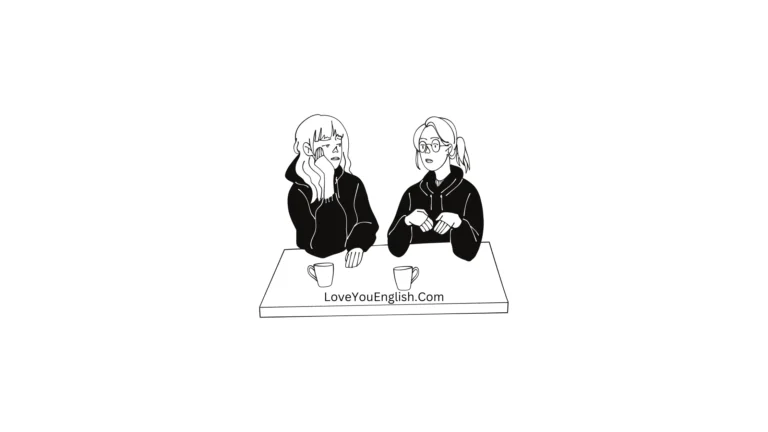Spoken English Conversations at A School
Sharing is caring!
Teacher: Good morning, Sarah!
Sarah: Good morning, Mrs. Johnson!
Teacher: How are you today?
Sarah: I’m good, thank you. How are you?
Teacher: I’m great, thanks for asking. Are you ready for today’s lesson?
Sarah: Yes, I’m ready. What are we learning about today?
Teacher: Today, we’re going to talk about plants. We’ll learn about how they grow and what they need to stay healthy.
Sarah: That sounds interesting! Do we have any special activities?
Teacher: Yes, we do! We will be planting seeds and observing them over the next few weeks.
Sarah: Wow, that sounds fun! What kind of seeds are we planting?
Teacher: We’re planting sunflower seeds. Sunflowers are easy to grow and they grow very tall.
Sarah: Cool! I like sunflowers. Do we get to take them home?
Teacher: Yes, you can take them home once they are big enough. We will also keep a class journal to record their growth.
Sarah: I can’t wait to see how they grow. What do we need to do for the planting?
Teacher: We will need some soil, pots, and water. I will show you how to plant the seeds and take care of them.
Sarah: Will we be using our science books for this?
Teacher: We will use the science books to read about plants and their needs. But for planting, we will use the materials here in the classroom.
Sarah: I’m excited to start. When do we begin?
Teacher: We will start right after we finish our reading time. First, we’ll read a few pages from the book and then we will plant the seeds.
Sarah: Okay, I’m ready for reading time too. What will we read about?
Teacher: We will read a story about a little seed that grows into a big plant. It will help you understand the process of plant growth.
Sarah: That sounds nice. I like stories with plants in them.
Teacher: I think you will enjoy this one. After the story, we will talk about the different parts of a plant and what each part does.
Sarah: I didn’t know there were so many parts to a plant. What are they?
Teacher: Well, there are roots, stems, leaves, flowers, and seeds. Each part has an important job. For example, roots take in water and nutrients from the soil.
Sarah: I didn’t know that. I’m looking forward to learning more.
Teacher: That’s the spirit! Alright, let’s get our books and start reading.
Sarah: Okay! I’m excited for both the reading and the planting.
Teacher: I’m glad to hear that. Let’s get started!
After the Reading
Teacher: Now that we’ve finished the story, are you ready to plant the seeds?
Sarah: Yes, I’m ready!
Teacher: Great. Let’s get the soil and the pots. We’ll fill each pot with soil, then put two seeds in each pot.
Sarah: Do we put the seeds deep into the soil?
Teacher: Not too deep. Just a little bit below the surface. After that, we will water them gently.
Sarah: How often should we water them?
Teacher: We will water them once a day. Not too much, just enough to keep the soil moist.
Sarah: Got it. Can I help with the watering too?
Teacher: Of course! You can help water the plants every day. It will be part of your responsibility for the class project.
Sarah: I’m excited to take care of the plants. What do we do after we plant the seeds?
Teacher: We will keep the pots in a sunny spot in the classroom. We’ll check them each day and write in our journals about what we see.
Sarah: Will we also talk about how to take care of plants?
Teacher: Yes, we will discuss it each week. We’ll talk about what plants need to grow, like sunlight and water.
Sarah: I’m really excited for this project. I hope our plants grow well.
Teacher: I’m sure they will! It will be fun to watch them grow together.
Sarah: I can’t wait. Thanks for the lesson, Mrs. Johnson.
Teacher: You’re welcome, Sarah. I’m happy you’re excited. Let’s start planting!
Read more conversations:
- Daily English Dialogues Practice
- English Dialogue: A Friendly Social Event
- English Dialogues Practice: At the Coffee Shop
- English Dialogues Practice: At a Wedding
- English Dialogues Practice: Casual Talk
Spoken English Conversations at A School
Teacher: Hi, Tom! How are you doing with your group project?
Tom: Hi, Mrs. Smith. We’re doing okay, but we’re not sure about a few things.
Teacher: What seems to be the problem?
Tom: Well, we’re working on the project about famous landmarks, and we’re not sure how to divide the tasks.
Teacher: That’s a good question. Let’s talk about how you can divide the work. What have you and your group decided so far?
Tom: We decided to focus on the Eiffel Tower in Paris, but we’re not sure who should do what.
Teacher: That’s a great choice! The Eiffel Tower is an interesting landmark. Have you thought about what parts of the project you need to cover?
Tom: We know we need to cover the history, architecture, and interesting facts about the Eiffel Tower. But we’re not sure who should do each part.
Teacher: Let’s break it down. For history, you could talk about when it was built and why. For architecture, you could explain how it was designed and built. And for interesting facts, you could share fun or lesser-known information about the Eiffel Tower.
Tom: That makes sense. So, should we each pick one of these parts?
Teacher: Yes, that’s a good idea. You can also think about who might be most interested in each topic. For example, if someone in your group likes history, they could do the history part.
Tom: Okay, I think Lisa likes history, so she can do that part. What about architecture?
Teacher: Is there someone who enjoys drawing or looking at building designs? They might be a good fit for the architecture part.
Tom: Oh, James likes drawing and he’s good with designs. I think he should do the architecture part.
Teacher: That sounds perfect. And for interesting facts, maybe you can do that part if you enjoy finding fun details.
Tom: I do enjoy finding interesting facts! So I will do that part.
Teacher: Great. Now you just need to make sure you have a plan for how you will share your information. Will you make a poster, a PowerPoint presentation, or something else?
Tom: We were thinking of making a poster, but we’re not sure what it should look like.
Teacher: A poster can be very effective. You can have sections for each part of your project. You could use pictures, diagrams, and text to make it interesting and informative.
Tom: That sounds good. We can make a big poster with different sections for history, architecture, and interesting facts.
Teacher: Exactly. And don’t forget to add a title and maybe some fun facts or pictures of the Eiffel Tower.
Tom: Got it. We also need to practice what we will say when we present. Do you have any tips for that?
Teacher: Yes, practice is very important. Make sure each person in your group knows what they will say and when. You can also practice together to help each other.
Tom: That’s a good idea. We can practice our parts in front of the class before the actual presentation.
Teacher: That’s a great plan. Also, try to speak clearly and make eye contact with your audience. It will help make your presentation more engaging.
Tom: I will keep that in mind. Do you have any other advice for our project?
Teacher: Just remember to work together and support each other. If you have any questions or run into problems, feel free to ask for help.
Tom: Thanks for the advice, Mrs. Smith. I think we’re on the right track now.
Teacher: You’re welcome, Tom. I’m glad I could help. I’m looking forward to seeing your project!
Tom: We’re excited too. We’ll get started on the tasks and work on the poster this week.
Teacher: That sounds like a good plan. Have fun with your project, and let me know if you need anything.
Tom: Will do! Thanks again.
Teacher: You’re welcome. Have a great day, Tom!
Tom: You too, Mrs. Smith!
Later in the Week
Lisa: Hi Tom, we’re almost done with the history part. Do you have your facts ready?
Tom: Hi Lisa! Yes, I have some interesting facts about the Eiffel Tower. I’ll show them to you now.
Lisa: Great! Let’s look at them and decide what to put on the poster.
Tom: Okay. I found out that the Eiffel Tower was built for the 1889 World’s Fair and that it was the tallest building in the world until 1930.
Lisa: Those are great facts! We can definitely put that on the poster. I also have some information about the history of how it was built.
Tom: Awesome. Let’s put your history details in the top section of the poster and my facts in the bottom section.
Lisa: Sounds good. I’ll get started on the writing while you work on the pictures.
Tom: Perfect. I’ll find some nice pictures of the Eiffel Tower to add to our poster.
Lisa: Thanks, Tom! We’re almost finished.
Tom: Yes, we are! I’m excited for the presentation.
Lisa: Me too. I think we’re going to do a great job.
Tom: I agree. Let’s finish up and then we can practice our parts together.
Lisa: Good idea. Let’s get to work!
Sharing is caring!





